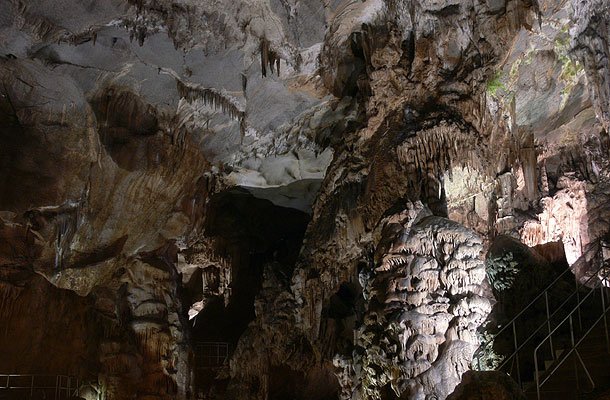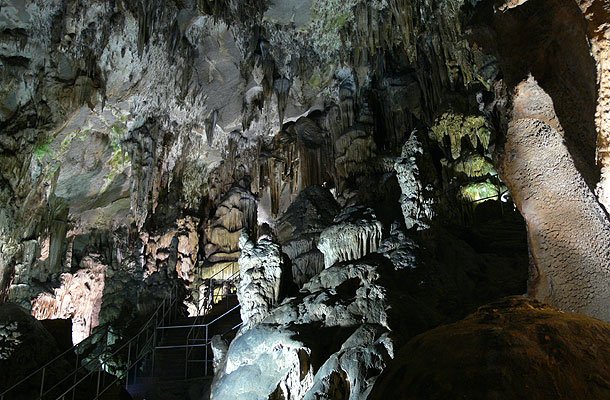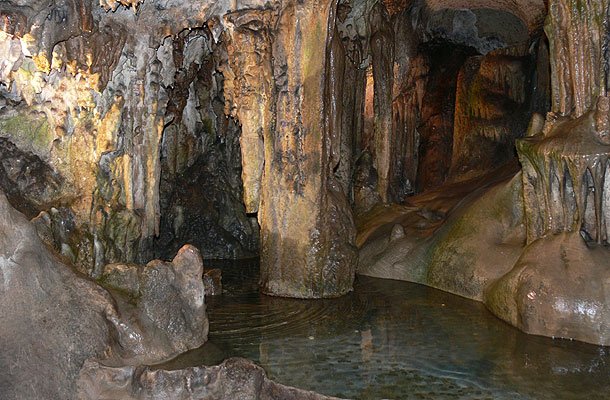The house of the Riding hag, the Wife of the Giant, Santa Claus, magnificent waterfalls… We can see all this in the Ledenika Cave which is one of the most beautiful ones in Bulgaria. These amazing Karst formations which have been forming for thousands of years meet the tourists over the last 50 years.

© Photo: www.imagesfrombulgaria.com
The history of the Ledenika Cave started way back in time. Local people discovered it many centuries ago. The shepherds used the low temperature of this place to preserve their milk there. Later they discovered a small hall entitled the refrigerator. There, the manufacturers of silk cocoons stored the silkworm seeds. Ledenika cave is situated in the Vratchanska Mountain, some 20 kilometers away from the town of Vratsa (Northwestern Bulgaria). Since 2000, this cave has been kept by the municipality of Vratsa. We learn more from Ventsislav Nikolov, managing director of the municipal enterprise “Sport and Tourism”.
“In 1923 the renowned tradesman from Vratsa region Hristan Chomakov who owned lands around the cave donated the cave and around 10 hectares of forests and pastures to the tourist association Veslets. At the beginning of the 1960’s this place was opened for tourists. Before it was officially opened, metal fences and illumination were installed in the cave. Many concerts have been held for decades in the so-called Concert hall in this cave, as the acoustics there is incredible. Once, the cave was full of water which gradually disappeared, creating interesting formations. Each winter ice figures emerge in it, only to disappear when the weather gets warm. The Karst stalactites and stalagmites though have been present in this cave for centuries. The water drops have been forming tirelessly these rocks which later turned into an underground kingdom. It is enough to know that 1 centimeter of their height is formed for 100 years”, says Ventsislav Nikolov.

© Photo: www.imagesfrombulgaria.com
The cave is some 300 meters long and is situated 830 meters above the sea level. All ten halls lie on several floors. The Antechamber hall takes you through a low and narrow passage called Passage of the sinners. The legend has it that those who fail to go through this passage have many sins.

© Photo: www.imagesfrombulgaria.com
“This is followed by the Small Hall and the Concert Hall”, Mr Nikolov goes on to say. “The formations there bear colorful names- “The giant’s head, “The crocodile”, “The falcon”, formations resembling swords, shields and maces are hanging from the top of the cave. There visitors can see the house of the Riding hag and many other formations. Metal bridges take you over the “Small abyss” and the “Big abyss”. Then, through the small passage called “The curtains” we reach the beautiful chamber entitled “The white hall”. The figures in this hall also bear interesting names such as “The elephant” and “The girl who takes a bath”. The highest point of the cave is called “The seventh sky”, but the road to it is accessible only to the keenest and best equipped tourists. The temperature in the cave ranges between -7°C and -15°C to around 8°C. The high temperatures are measured in the inner side of the cave in the “Small hall” chamber. A small lake with a depth of 0.50 meters lies not far from this place. According to the legend it collects the tears of the mountain and can fulfill wishes. ”

© Photo: www.imagesfrombulgaria.com
The “Magic Lake” dates back to the times when the whole cave was full of water. An old belief has it that of you put your hand into its cold waters and make a wish it will come true for sure. All visitors do this. Their number amounts to over 50 000 per annum.
Currently an amusement park which will bear the name of the cave is under construction near Ledenika cave, says Ventseslav Nikolov. It will consist of interesting topical and entertaining modules. Modern audio and visual equipment will inform the curious tourists about the history of the cave as well as about the rare animal and plant species that live in it. Their number exceeds 50. For example the insect called Svetlomrazets (Light hater) can only be met at this place. The most attractive module which will be created near the entrance of the cave will bear its name. It will be manufactured by a transparent material and will be in the shape of this rare insect. Many halls where historical facts will be presented are also under construction. The educational modules such as “ The bat”, “ Amphitheatre”, “ The wonderful walk” and the Alpine rope area called ” Mom, dad and us” are only part of the amusement park. According to the project, the Ledenika Park should be completed by November 1, 2013. The work time of the cave remains unchanged- from 9 am to 4.30 pm during the winter season and from 8.30 am to 5.30 pm in summer time.
English version: Kostadin Atanasov
An architectural and cultural monument of national importance, the church of Saint George the Victorious in the town of Kyustendil is located at the foot of the nearby Osogovo Mountain, in Kolusha neighbourhood. The study and restoration of..
We do not need to travel thousands of kilometers to reach holy Christian places and “drink from the miraculous well” of Orthodox faith. Hundreds of churches and monasteries were built on Bulgarian territory with the faith and the hope..
A hard-to-reach fortress rose on a solitary ridge, which was towering above the Asenitsa River. This place built high in the rocks was once sheltering Thracians, Romans, Byzantines, Western Europeans, Bulgarians and Ottomans. One..

+359 2 9336 661
